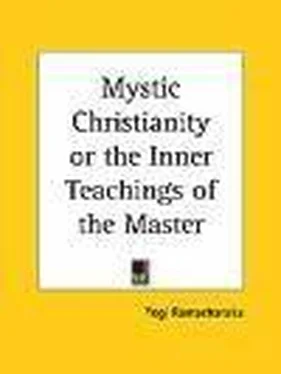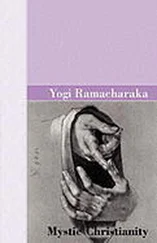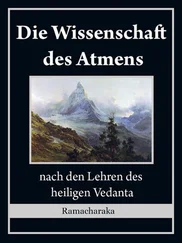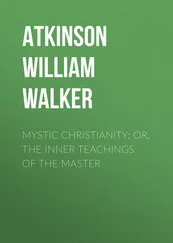The Essenes were an ancient Hebrew Occult Brotherhood, which had been in existence many hundred years before John's time. They had their headquarters on the Eastern shores of the Dead Sea, although their influence extended over all of Palestine, and their ascetic brothers were to be found in every wilderness. The requirements of the Order were very strict, and its rites and ceremonies were of the highest mystical and occult degree. The Neophyte was required to serve a preliminary apprenticeship of one year before being admitted to even partial recognition as a member and brother. A further apprenticeship of two more years was required before he was admitted to full membership, and extended the right hand of fellowship. Additional time was required for further advancement, and even time alone did not entitle the member to certain high degrees, the requirements being that actual knowledge, power and attainment must first be manifested. As in all true Occult Orders the candidate must "work out his own salvation," neither money nor influence having any weight.
Absolute obedience to the Rules of the Order; absolute poverty of material possessions; absolute sexual continence-these were the conditions of membership to be observed by both Neophyte and Initiate, as well as High-degree Master. Understanding this, one may imagine the disgust inspired in John by the amorous solicitations of Salome, which caused him to lose his life rather than to break the vows of his Order, as is so startlingly pictured in the stage productions of modern times.
One of the ceremonies of the Essenes was that of Baptism (literally, "dipping in water") which was administered to Candidates, with appropriate solemnity and rites. The mystic significance of the ceremony which is understood by all members of Occult Orders, even unto this day, was a part of the ritual originated by the Essenes, and the rite itself was a distinctive feature of their Order. The performance of this rite by John the Baptist, in his ministry, and its subsequent acceptance by the Christian Church as a distinctive ceremonial, of which the "sprinkling of infants" of to-day is a reminder and substitute, forms a clear connecting link between the Essenes and Modern Christianity, and impresses the stamp of Mysticism and Occultism firmly upon the latter, as little as the general public may wish to admit it in their ignorant misunderstanding and materialistic tendencies.
The Essenes believed in, and taught the doctrine of Reincarnation; the Immanence of God; and many other Occult Truths, the traces of which appear constantly in the Christian Teachings, as we shall see as we progress with these lessons. Through its Exalted Brother, John the Baptist, the Order passed on its teaching to the early Christian Church, thus grafting itself permanently upon a new religious growth, newly appearing on the scene. And the transplanted branches are still there!
Of course, the true history of the real connection between the Essenes and Christianity is to be found only in the traditions of the Essenes and other ancient Mystic Orders, much of which has never been printed, but which has passed down from teacher to pupil over the centuries even unto this day, among Occult Fraternities. But in order to show the student that we are not making statements incapable of proof by evidence available to him, we would refer him to any standard work of reference on the subject. For instance, if he will consult the "New International Encyclopedia" (Vol. VII, page 217) article on "Essenes," he will read the following words:
"It is an interesting question as to how much Christianity owes to Essenism. It would seem that there was room for definite contact between John the Baptist and this Brotherhood. His time of preparation was spent in the wilderness near the Dead Sea; his preaching of righteousness toward God, and justice toward one's fellow men, was in agreement with Essenism; while his insistence on Baptism was in accord with the Essenic emphasis on lustrations."
The same article contains the statement that the Essenic Brotherhood taught a certain "view entertained regarding the origin, present state, and future destiny of the soul, _which was held to be pre-existent, being entrapped in the body as in a prison_," etc. (The above italics are our own.)
John emerged from the wilderness when he had reached the age of about thirty years, and began his ministry work, which extended for several years until his death at the hands of Herod. He gathered around him a large and enthusiastic following, beginning with the humbler classes and afterward embracing a number of higher social degree. He formed his more advanced followers into a band of disciples, with prescribed rules regarding fasting, worship, ceremonial, rites, etc., closely modeled upon those favored by the Essenes. This organization was continued until the time of John's death, when it merged with the followers of Jesus, and exerted a marked influence upon the early Christian church.
As we have stated, one of his principal requisites enjoined upon all of his followers, was that of "Baptism"-the Essenic rite, from which he derived his familiar appellation, "The Baptist." But, it must be remembered that to John this rite was a most sacred, mystic, symbolic ceremony, possessing a deep occult meaning unperceived by many of his converts who submitted themselves to it under the fervor of religious emotion, and who _naively_ regarded it as some magical rite which "washed away sin" from their souls, as the dirt was washed from their bodies, a belief which seems to be still in favor with the multitude.
John worked diligently at his mission, and the "Baptists" or "Followers of Johanan," as they were called, increased rapidly. His meetings were events of great moment to thousands who had gathered from all Palestine to see and hear the prophet of the wilderness-the Essene who had emerged from his retirement. His meetings were often attended with startling occurrences, sudden conversions, visions, trances, etc., and many developed possession of unusual powers and faculties. But one day there was held a meeting destined to gain world-wide fame. This was the day when there came to John the Baptist the MASTER, of whose coming John had frequently foretold and promised. JESUS THE CHRIST appeared upon the scene and confronted his Forerunner.
The traditions have it that Jesus came unannounced to, and unrecognized by John and the populace. The Forerunner was in ignorance of the nature and degree of his guest and applicant for Baptism. Although the two were cousins, they had not met since childhood, and John did not at first recognize Jesus. The traditions of the Mystic Orders further state that Jesus then gave to John the various signs of the Occult Fraternities to which they both belonged, working from the common signs up until Jesus passed on to degrees to which John had not attained, although he was an eminent high-degree Essene. Whereupon John saw that the man before him was no common applicant for Baptism, but was, instead, a highest-degree Mystic Adept, and Occult Master-his superior in rank and unfoldment. John, perceiving this, remonstrated with Jesus, saying that it was not meet and proper, nor in accordance with the customs of the Brotherhoods, for the inferior to Baptize the superior. Of this event the New Testament takes note in these words: "But John forbade him, saying, I have need to be baptized of thee, and comest thou to me?" (_Matt. 3:14._) But Jesus insisted that John perform the rite upon him upon the ground that He wished to go through the ceremonial in order to set His stamp of approval upon it, and to show that he considered himself as a man among men, come forth to live the life of men.
In both the occult traditions and the New Testament narrative, it is stated that a mystical occurrence ensued at the baptism, "the Spirit of God descending like a dove and lighting upon Him," and a voice from Heaven saying: "This is my beloved Son in whom I am well pleased."
Читать дальше












